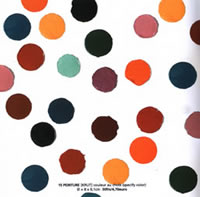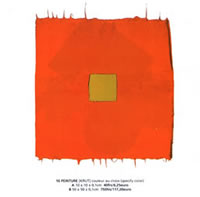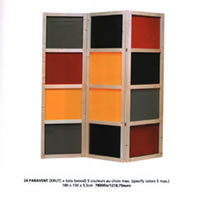|
Part 1
Why did you begin to study art? What made you
strike out for art? What did you study at school?
When
I was a child, I was already interested in drawing
and painting. I had the chance to
be able to work in the atelier of my father,
constructing sculptures in wood, or modeling
in earth etc. I remember the garden of my parents,
full of painted sculptures that made sound with
the wind, stone sculptures and so on. In the
cellar, I was painting on an enormous canvas.
Actually, then I decided to go to in a specific
school to study art and then the Beaux-Arts school.
I quit school just before the big exam, and worked
like hell to prepare some interviews in different
art school in France. I was accepted in several
of them, but chose the one located in Besançon,
the city of my girlfriend. The problem was that
I didn't pass the interview, so I convinced the
director to give me the chance to enter just
like this, on the phone, and he accepted. I understood
two things from this experience: the power of
words and my capability to use it. So I entered
this small art school. In Besançon and
worked a lot for 5 years but the school was not
enough so I always had a personal atelier and
was making works for the city, in the street,
in theater and started to exhibit here and there.
I experienced a lot of different things; I made
some scenographies for contemporary music in
theaters and created some settings for cultural
events. Besides, I created a free postcard reseau,
and opened a gallery next to my atelier, which
is still running after 10 years. All kinds of
experiences are still useful now. I was also
designing furniture for companies and myself,
already thinking about the ways to put them in
society. All my production was already painted
in different styles. I worked in all kinds of
directions, from monochrome to "figuration
libre",
At that time, I was searching and searching,
interested in everything. I’m still like
this in the way that I want my works to exit
in all possible directions and that is what’s
happening now. I create paintings for the visual
arts, for the design world, and on architecture.
I worked everywhere, from the street to museum,
galleries, public or private spaces, specific
commissions and so on. Boundaries do not really
exist for me. Neither do classifications. And
new generations of artists are working like this
way. There will be a big change in the coming
years about definitions. Exactly as Joseph Beuys
says.
At school, I tried to concentrate on my experiences
in all kinds of directions. I studied painting
in a broad sense, from Lascaux till today, and
understood that everything touched me somehow,
the way humans are using paint is an enormous
world.
The shock came with people like Kazimir Malevich(1878-1935),
Marcel Duchamps(1887-1968), Joseph Beuys(1921-1986),
Robert Ryman(1930-), Bertrand Lavier(1949-),
the pop artists, Jackson Pollock(1912-1956),
Gerard Gasiorowski(1930-1986) but also sculptors
like Didier Vermeiren(1951-), Siah Armanjani(1931-),
Etienne Bossut(1946-) and a lot of other people.
I turned out works in the follow up of Support/Surface,
a small movement in France. I was interested
in improving everything about paint and painting.
I had already started to have physical distance
from it, and then after I had invented the [krut],
and finished my studies with it.
 |
 |
 |
" PUBLIC ART-STREET
SCULPTURE"
1999 |
Could you explain about [Krut]?
The
[krut] was the end of my research about painting
in the 20 century which
I started 7 years ago. I even have a painting
when I was 15, using one [krut] on a painting!
It was the logical consequence to the deconstruction
of the painting: after using my feelings to paint,
after asking questions about the physical aspect
of the canvas, after making sculptures to paint,
after putting [krut] on canvas, after leaving
the canvas, after the use of the wooden frame,
after "the 12 last paintings", I had
only one thing, a piece of pure paint, a [krut],
I started all kinds of experiences with it, exhibiting
a bit with it, trying all kinds of things. I
used it for several years.
I created this word, [krut], which doesn't exist
except in my vocabulary. I had to invent a word
for something that I invented; the coat of pure
paint used as a material, as an object etc. At
the start, some years ago, I wrote it, ‘croûtes’.
In French, it can mean the coat on the top of
the milk when you burn it or the coat that makes
the blood when it dries, BUT it is also an expression
about a bad painting, like a Sunday painting.
It is also a reference to Gerard Gasiorowski,
one of the best artists/painters from the 20th
century to me, who is a Romanian artist based
in France.
[krut] was the rich experience that I wanted
to share, and still support by mail order catalogue.
So you can find in this catalogue a resume of
7 years of production, which I selected. It is
about painting, sculptures, languages, and historical
references such as Rene Magritte (1898-1967),
Klein, Opie, Robert Ryman, Marcel Duchamps, Pablo
Picasso(1881-1973), Gerard Gasiorowski and a
lot of people.
I had a chance to know
your project, Urban Concern in Amsterdam. I
felt close in our conversations,
and I was hoping we could work together someday.
I believe that artists themselves should think
about why they make artworks, and their role
in society as artists, and create the platform
for representations. So, I was very excited when
I encountered your projects and idea. Why did
you decide not to produce new work as art pieces
but to paint objects around you to restore daily
life with colours? How do you see streets, buildings
and objects around you?
When I entered
the Rijksakademie in Amsterdam, I discovered
an international situation; things
get new definitions and I understood that I could
go further somehow. I could have chosen to continue
all my life with [krut], but I decided to work
on something more interesting to me: the garbage
AND the paint that I’ve been doing so far.
I did not want to specify myself only in a technical
way with pure definitions about art. I had to
change the rules and have my personal definitions.
It was easy for me to stop creating new objects
just by considering what was around me. It is
a direct response to the industrialization of
the 19th and 20th century and to mass production
creating garbage, leftover etc. The Shakers,
the UAM, the Bauhaus, De Stijl, everything from
this period was impressive to me; these kinds
of society projects as utopic items. I look at
my object production as paintings in 3 dimensions,
useful, and then of course, link with design
appear. So now, I’m actually working in
different fields, with different contexts and
people not always concerned with the same ideologies,
but I like it this way. Boundaries do not exist
in my work and you’re free to look at it
the way you want.
I defined myself as a realistic painter. The
fact to be a realistic painter comes from the
subjects I paint, which has a real function,
a real existence. It is realistic also because
of the choice I make to put my concerns in the
public domain or you work with a specific population,
like working in secondhand enterprises, for instance.
You can reach political subjects and ideas about
the way in which society is functioning.
Streets
provide a lot of information about the society
surrounding them. In St. Petersburg,
there is almost nothing in the street. In Osaka,
a lot of homeless people and bikes without locks!
In New York, you can find amazing objects. In
the Vatican, the only thing I found was money...it
is really symbolic. In the Netherlands, you find
new objects in the street. I have more than 1000
objects collected from the streets collection
Amsterdam; only things that are useful and sometimes
even still with their original packaging.
I remember one shock I had when I was a little
boy. It was in Morocco. I threw away a bottle
in a public dustbin and when we left, a lot of
children ran toward it, and took the bottle.
This image is still in me, like it was only yesterday.
I’m sure they did something or transformed
it; there are a lot of things to do with leftovers
or garbage, and there is a worldwide consciousness
about this.
 |
" PUBLIC ART-STREET
SCULPTURE"
1999 |
Do you
have some examples of artists that are interesting
to you?
I put my own definitions of art or artist,
for example, they are not so-called artists,
but
In Chile, there are some guys searching for
solutions to collect the water from clouds in
order to
give water to people. The work of these people
is just to find water. It took them 40 years
to create nets that succeeded. I find this
kind of thing extraordinary. Duchamps was saying
that
the context was making the art piece, I think
it is the artist, who create sense of its surrounding.
There are not many artists that I feel close
to, but some people, like Lina bo Bardi, Gerrit
Rietveld, and Donald Judd are really important
to me.
I am not looking for names or reference that
are anyway the same for everybody in the art
world, I am curious about a lot of action,
and a lot people do create senses for me. New
definitions
means also new approach and new ways of apprehending
the world. So in broad sense, people which
are transforming the world, taking position
in a
critical way, saying what they really think,
these are the artists I am referring to.
******************
Long
Interview vol.3 Franck Bragigand archive
>> Part2 |